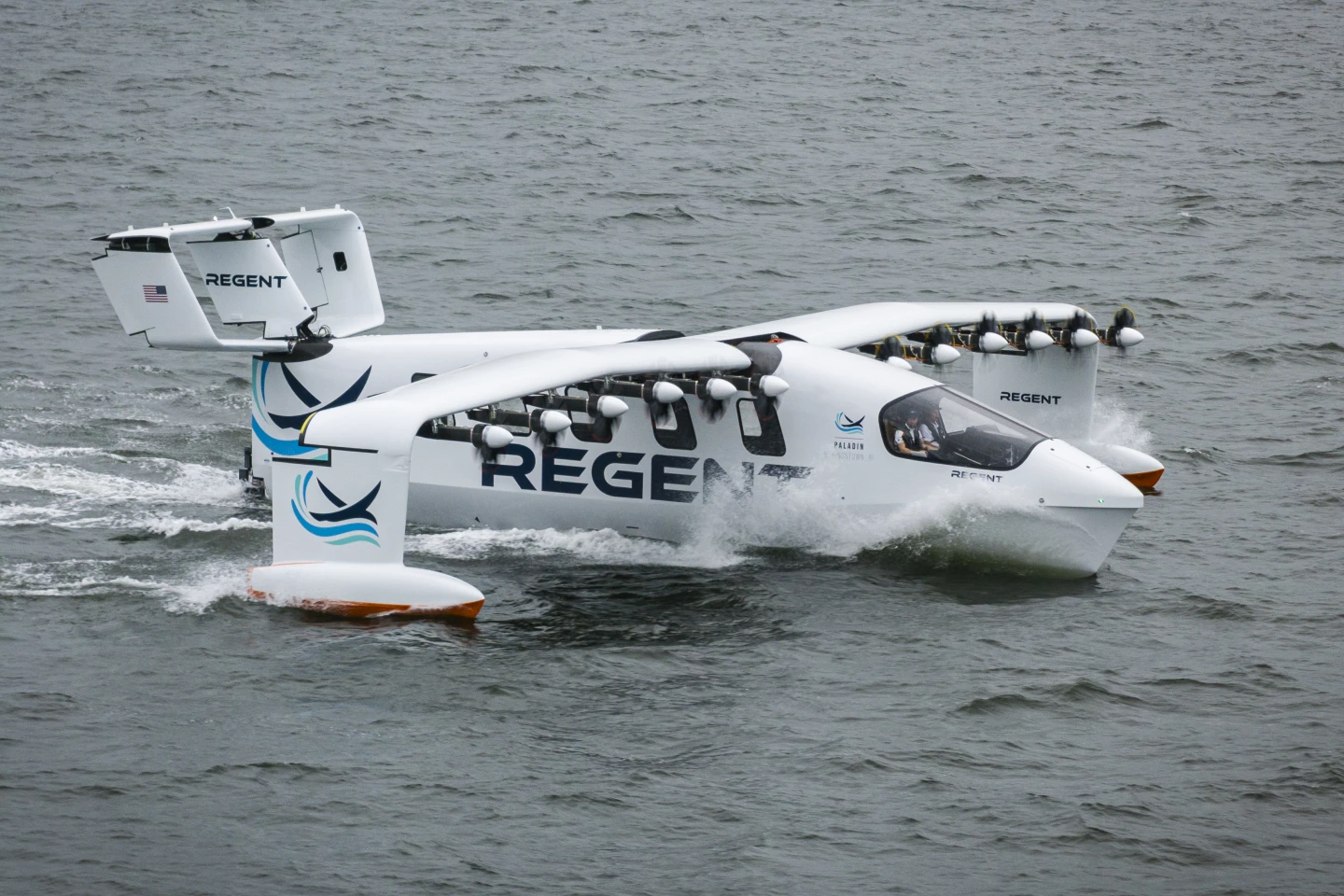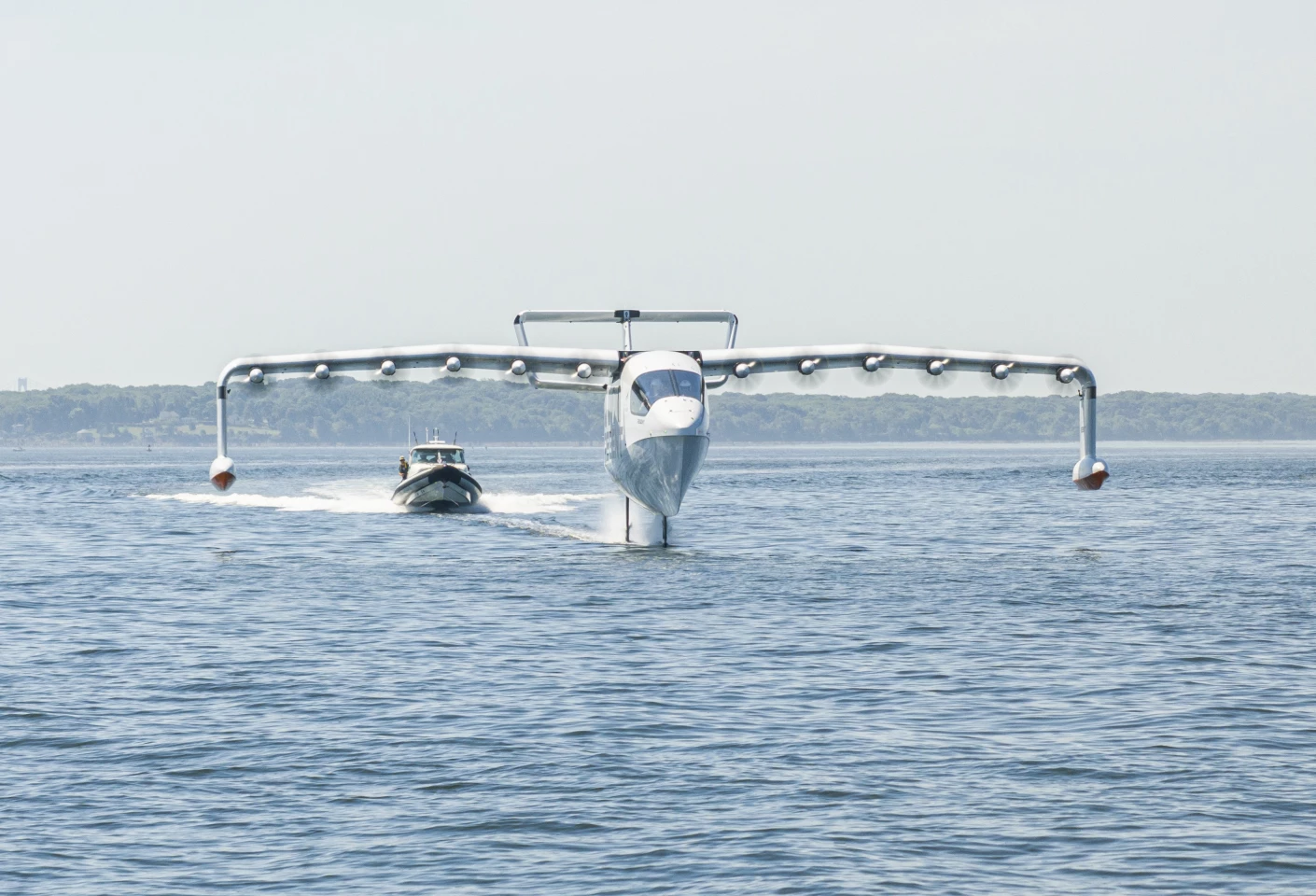Designed to provide the range, speed and convenience that electric aircraft and boats lack, the otherworldly Viceroy seaglider developed by Rhode Island startup Regent has completed another major milestone. Just a few months after hitting the water for the first time, the dramatic gull-winged vessel emerged out of the water to demonstrate its foiling capabilities for the first time. Pretty soon, it will be taking to the air to put its range-boosting ground-effect technology to work.
As we’ve looked at in the past, the 55-ft-long (16.8-m) Viceroy is a unique craft designed to navigate coastal waters in three modes: float, foil and fly. It can float on its robust fuselage-hull at low speeds around harbors before speeding up on the open water and lifting onto its hydrofoils for speeds up to 58 mph (93 km/h).
From there, the pure-electric vessel’s main claim to fame – wing-in-ground-effect – takes over, allowing the Viceroy to fly within a single 65-foot (20-m) wingspan’s height over top the water surface below, using the resulting air cushion between wing and water to boost lift and glide forward with high efficiency.
The 12-passenger, 15,000-lb (6.8-tonne) Viceroy never rises higher than that extreme-low-altitude pocket, with an aim of reliably delivering a range Regent estimates at 180 miles (290 km) per charge. The company believes it will be able to extend that range to 400 or 500 miles (640 to 800 km) per charge as battery technology evolves and energy densities improve in the coming years and decades. It aims to provide a convenient zero-emissions travel and cargo shipping solution for connecting regional coastal destinations.

Amory Ross/Regent
After completing initial testing with a quarter-scale prototype in 2022, Regent launched its full-scale prototype testing regimen earlier this year. It began sea trials in “float” mode back in March, after completing rigorous subsystem testing.
In late June, it moved forward to the next testing stage, operating in crewed hydrofoil mode for the first time. As you can witness in the video clip below, the massive not-quite-a-boat accelerates forward on its hull before hitting speed and slowly rising up on its foils like a great sea beast rising above waterline at feeding time. It foils along for a while before gradually lowering its hull back into the water.
REGENT Seaglider Completes Successful First Foil Testing
“Seeing our seaglider prototype rise onto foil for the first time marks a major milestone and a powerful validation of the years of innovation, grit and world-class engineering our team has poured into this vision,” said Regent CEO and cofounder Billy Thalheimer. “This achievement brings us one step closer to crewed flight, and we couldn’t be more excited for what’s ahead.”
Hydrofoil operation allows for smoother, nimbler, more efficient on-water navigation, and gets the Viceroy up to takeoff speed for transition to blown-wing flight. It’s one of the key features that separate the Viceroy design from previous attempts at viable ground-effect crafts, such as the Soviet-era Caspian Sea Monster ekranoplan. Regent explains that the hydrofoils allow the Vicreroy to operate like a boat outside harbor areas, giving it the speed, maneuverability and choppy water stability that failed ekranoplans lacked. Once airborne, the foils retract away into the hull, reemerging after landing.

Amory Ross/Regent
Regent has stated that it will commence the first full Viceroy flight tests in 2025, and the successful foil tests complete a major step toward that goal. Earlier this year, it also submitted its Design Basis Agreement (DBA) to the US Coast Guard following months of collaboration with the agency. Because the vessel always remains in ground effect, within one wingspan of the surface, its regulation and certification ultimately fall to the Coast Guard rather than the Federal Aviation Administration (FAA).
The DBA specifies how the Viceroy seaglider will show an equivalent level of safety to similarly sized certified vessels. Approval of the plan is expected in the coming months.
Following that approval, Regent explains that it will move toward finalizing the Viceroy design, which the Coast Guard will then approve. The Coast Guard will inspect the design during construction to ensure it follows the plan, and the final steps will involve Regent working with local operators on crew training and requirements before the vessel is certified for commercial passenger operations.

Amory Ross/Regent
Regent will also be completing equivalent certification processes in other countries around the world so its crafts and operators are ready for launch in additional target markets. It says it has logged over $10 billion worth of orders from customers around the world. It plans to bring online its 255,000-sq ft (23,700-sq m) manufacturing facility in Rhode Island’s Quonset Business Park in 2026.
The 3.5-minute video below features some key Regent crew members discussing the hydrofoil testing.
Maiden Foil Achieved
Source: Regent








